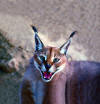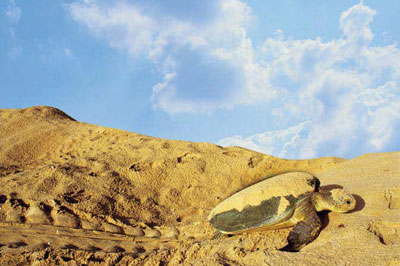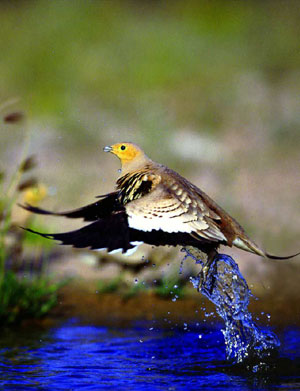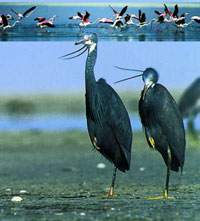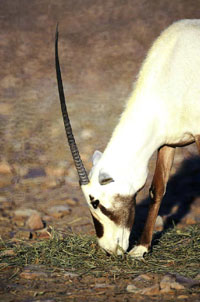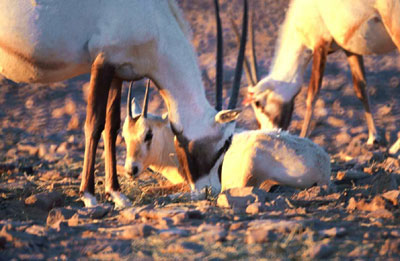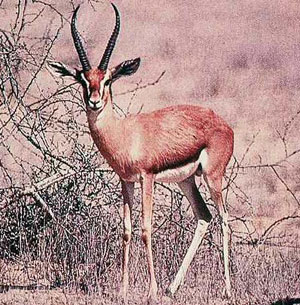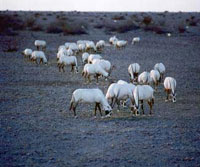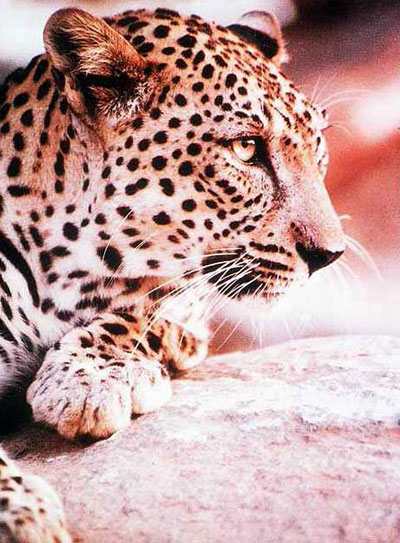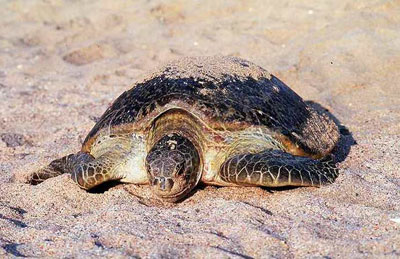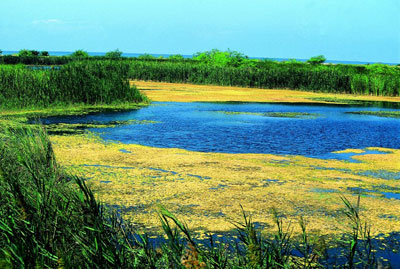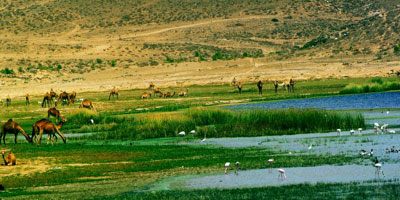Oman has a surprisingly varied wildlife, both on land and in the surrounding waters. Strict laws have been established to ban hunting as a number of indigenous animals have now become endangered, such as the Arabian leopard and the Arabian Oryx. Nature reserves have been set up throughout the Sultanate to protect the natural habitats of mammals such as the leopard, Oryx, gazelle, taher, ibex, desert foxes and wild cats.
The warm waters are home to 22 species of whale and dolphin. Oman is a member of the International Whaling Commission and follows the Convention of International Trade in Endangered Species (CITES) guidelines in preventing the trade of endangered animals. Turtles are attracted to Oman's shores and turtle breeding reserves are located at Ras al-Jinz and the Dimaaniyat Islands. Oman has a profusion of exotic marine life and some of the best dive sites in the world. In particular, the Hallaniyat Islands and the Dimaaniyat Islands offer chances to see beautifully coloured tropical fish and unusual hard and soft corals.
The al-Saleel park is a nature reserve located in the town of al-Kamil wal-Wafi, in the Interior of Oman, and was established to protect gazelles and plantations of Samr and Ghaf trees (Acacia tortilis and Cineraria). The Jiddat al-Harasis Reserve is home to the Arabian Oryx and the area is listed on the World Natural and Cultural Heritage register by UNESCO.
Approximately 400 birds have been recorded in Oman during the seasons. Because it is located at the hub of three different geographical land masses, Oman is host to many foreign species, such as the Golden Oriole, Nightjar and White Stork. In the breeding season, public entry is prohibited to the Dimaaniyat Islands, where there is a bird sanctuary. During September to November, many eagles migrate to Oman, such as the Imperial Eagle and the Greater Spotted Eagle.
Birds
The Sultanate has three distinct climatic zones and this helps create suitable environments for a large variety of birds. Over 450 species of birds (out of 10,000 known worldwide) have been identified in the Sultanate of Oman, a country with limited rainfall: some are passage migrants, some are resident and some are breeding visitors.
There are just over 85 resident birds living in Oman all year round, while the majority are "migratory" birds which visit the country only at certain times of the year.
In Muscat Indian Rollers, Little Green Beeeaters, Yellow-vented Bulbuls, Graceful Prinias and the Purple Sunbirds can be seen at any time of the year.
Muscat is also one of the best places in the world to study the Steppe Eagle and one may see up to 100 at any one time.
Musandam, with its mountainous peaks rising to 2,000 metres is the home of the Chukar, a member of the Partridge family.
The eastern and central regions of Oman are the places to see shorebirds: Herons, waders, Sandpipers and Plovers migrate here from their breeding grounds along the shores of the Arctic Ocean in northern Europe and Siberia migrate here. And the Barr Al Hikman is famous for its flocks of Greater Flamingo.
The Batinah plain stretching between the mountains of the Western Hajar and the Gulf of Oman from Muscat to the UAE border holds farmland which is attractive to birds flying high during migrations. There are several important bird sites in this region: the offshore Sawadi islands have breeding Sooty Falcons in summer, and the Daymaniyat Islands in the Gulf of Oman have breeding Ospreys in winter and thousands of Bridled Terns and other tern species in summer. It is strictly forbidden to visit the Daymaniyat Islands from May to October.
The bird life of the southern region is quite different and here 30 species of birds are exclusively found: Ruppel's Weaver, Didric Cuckoo, African Scops Owl to name but a few.
The Arabian Oryx
The Arabian Oryx is a medium-sized antelope, weighing up to 90 kgs, that is exceptionally well adapted to life in the desert. It's natural habitat is a harsh climate and barren terrain with little water in which it sometimes has to cover distances of over 150 kilometres in search of new grazing. It can survive without water for long periods of time by drinking dew and fog water that has formed on the plants upon which it feeds. The oryx spends the heat of the day in the shade of trees during the hot season, only going out to graze and browse when it is cool. In winter it grazes in the daytime and shelters from cold winds at night.
The oryx has an unusual ability to interpret signals given by rain carried on the wind: this is particularly important for its survival in the desert. In response to these signals the dominant female oryx will lead a herd in search of the fresh pasture which will have resulted from the rainfall. The adult male oryx is usually territorial and rarely travels with the herds, that on average comprise 5 animals, usually females and their calves. Males will fight to defend females and territories from other males and this may result in injury or death.
The female oryx may give birth to its first calf, weighing 3-5 kgs, in the 22nd month of her life and thereafter she can give birthevery year, as the gestation period is 8.5 months. They may live to 20 years.
The last herd of Arabian Oryx in Arabia, in central Oman, was wiped out in 1972 as a result of indiscriminate hunting. Fortunately, in 1962 an international wildlife organisation had already rescued three animals in southern Arabia and joined by 8 animals donated from private collections of the region these few animals ensured the survival of the species until such time as circumstances would allow the oryx to be reintroduced into its natural range. This time came when in 1976 His Majesty Sultan Qaboos bin Said issued directives for the reintroduction of the oryx. And so it was that in March 1980 a herd of oryx arrived in the Sultanate from Phoenix Zoo in the USA to be released after 2 years of acclimatisation into the wild in the Jiddat Al Harasis, where the last oryx had been killed and where the local people pledged to protect the oryx. The reintroduction was a success and by 1996 the wild population numbered over 450, all but 19 of which were born in the desert.
In 1994 the area was declared the Arabian Oryx Sanctuary, Oman's first protected area, and later that year UNESCO listed the Sanctuary on its World Natural and Cultural Heritage Register.
Unfortunately the wild herds were severely reduced between 1996 and 1999 when poachers took oryx for live sale outside of the Sultanate. However, the poaching was stopped and new measures have been introduced locally and within the region to prevent further illegal capture and trade. These measures include the formation of a regional Committee for the Conservation of the Oryx - the first meeting of which was held in Muscat in 2000. Projects for environmental tourism with revenues reaching the local people and environmental education are underway in the Sanctuary and a new visitor centre has been built at the desert headquarters of the re-introduction project.
Wild Animals
For the Omanis, protecting wildlife and maintaining their natural habitat is nothing new, for wildlife reserves were once to be found in some areas of Oman. Reserves allowed wild species to find grazing even in the most severe drought conditions and, at the same time provided a sanctuary from hunters. Today Oman has seven formally designated protected areas for conservation of wild fauna and flora.
The Arabian oryx is perhaps the best known of Oman's wild animals. Other important species include:
Arabian leopard. Gone from most of the region the Arabian leopard still survives in the remote mountains of southern Oman. Modern techniques of camera-trapping and satellite collars have meant that the ecology of this shy and very secretive animal has been studied for the first time. The leopard is usually solitary only coming together with another animals for breeding. It is catholic in its diet but studies have shown that the Nubian ibex and rock hyrax form the bulk of its diet. Jebel Samhan Nature Reserve provides important sanctuary for the leopard, Arabia's largest of cats.
Arabian gazelle. The mature female gazelle weighs between 10 and 15 kgs. The male has thick horns while the female's horns are finer and straighter. Gazelles browse on shrubs and graze grasses.
The largest population is in the Arabian Oryx Sanctuary and numbers over 10,000 and is the largest single population in the region.
Reem gazelle (sand gazelle). This is a less common species and prefers the sandy terrain at the edges of the Empty Quarter. In contrast to the Arabian gazelle, the reem gazelle gives birth to twins. Like the oryx, the reem gazelle can cover long distances searching for new pastures.
Arabian tahr. This goat-like creature occurs primarily in Oman with just a few animals in the area of the Oman-United Arab Emirates border. It lives at altitudes of above 1000 metres where, unlike the drought tolerant oryx, it is dependent on small freshwater seepages.
The tahr live in small groups but at least once a year the males come together in a 'rut' to fight and compete for females. In the Wadi A' Serin Reserve the tahr are protected and monitored by a ranger force recruited from the local people.
Nubian ibex. Also a member of the goatlike family of animals the Nubian ibex is found in the Arabian Oryx Sanctuary and in the Jebel Samhan Nature Reserve. It does not occur in northern Oman where the Arabian tahr is found.
The ibex is a mountain animal that lives in small groups for most of the year. However, during the annual 'rut' groups of up to 30 animals come together with large adult males fighting for the right to breed.
Oman is also home to other mammals including the Blanfords fox, Ruppels sand fox, red fox, caracal lynx, wildcat, sandcat, Brandt's hedgehog, Ethiopian hedgehog, Indian-crested porcupine, genet, whitetailed mongoose, Arabian wolf, striped hyena, rock hyrax as well as numerous rodents.
The hunting, killing or capture of all wildlife species is illegal in Oman and offenders face sentence of up to five years imprisonment and fines of RO 5,000. This demonstrates the Sultanate's commitment to its wildlife.
In addition, the Sultanate ratified in 1994 the Convention for Biological Diversity - which is a global commitment to the conservation of wild animals and plants.
Sea turtles and the Humpback whales
Sea Turtles
The Sultanate has some of the most important sea turtle nesting beaches in the world, and in the case of the loggerhead turtle, probably the most important. It also harbours feeding grounds of international significance and migratory turtles pass through the coastal and offshore waters throughout the year.
The first surveys of turtles in Oman were undertaken in 1977 jointly by several Ministries, the IUCN (World Conservation Union) and WWF (Worldwide Fund for Nature). During the 1977-1986 period, 23,000 turtles were tagged. These tagging studies have confirmed that turtles nesting in Oman move great distances between nesting seasons, but return to very nearly the same place to nest.
There are 5 species of sea turtles that occur in Oman, four of which nest here: Green (Chelonia mydas) -which is endangered; Loggerhead (Caretta caretta); Olive Ridley (Lepidochelys olivacea) - the smallest; Hawksbill (Eretmochelys imbricata); Leatherback (Dermochelys coriacea)- the largest and a visitor only in offshore waters.
Sea turtles nest along the length of the Omani coast from Musandam in the north to Dhofar in the south, but some areas are more popular nesting sites: Ra's al Hadd (the most easterly point of Oman) is famous for its green turtle nesting population, whilst Masirah Island attracts the loggerhead in great number, and on the Daymaniyat Islands the hawksbill turtles set the record.
Conservation of turtles is high on the list of priorities in Oman:
All beaches in the Ra's al Hadd area are closed to campers, with the exception of Ras Al Junayz where a campsite has been opened, out of sight of the sea, in order not to disturb the turtles. A permit (for a small fee) is required to visit this site, and guides take campers down to the nesting grounds to watch the turtles come ashore and lay their eggs at night.
The Daymaniyat Islands Nature Reserve is Oman's only marine reserve and this is where hawksbill turtles are the main beneficiary.
Humpback Whales
Oman's waters support a large number of whales and dolphins. The most interesting of this is the humpback whale which elsewhere in the world is a migratory species - moving from breeding grounds in the warm tropics to feeding grounds in the cold polar waters. However, the highly productive waters of central and southern Oman, associated with the summer monsoon, allow the humpback to feed and breed in the same waters.
Nature Reserves
Facts and research taken from Ministry of Regional Municipalities and Environment's "Guide to Oman's Protected Species".
Ra's al Hadd Turtle Reserve
The Ra's al Hadd Turtle Reserve is located in the Wilayat of Sur in the Sharqiya region of the Sultanate. Its total area covers 120km2 with a coastline of 42km. The Ra's al Hadd Peninsula is of great importance as it attracts the largest number of nesting turtles in Oman. Between 6000 - 13000 turtles migrate here annually from the Arabian Gulf, the Red Sea and the East African coast. Contained within the reserve are many sites of historical importance such as Khawr al Jamarah, Ra's al Jinz and Ra's al Khaba. Specialist research studies are carried out in order to achieve the balance between protecting these areas and encouraging visitors. Many tourists visit the area to observe the estimated 20,000 nesting turtles. Oman is one of the most important sites for green turtles in the Indian Ocean.
Turtles spend most of their lives at sea but return to the land to lay their eggs. The sex of the unhatched turtle depends on the temperature of the sand in which the female lays her eggs.
Khawr al Jamarah contains a large mangrove plantation and many coral reefs. This type of environment is rich in crustaceans and plankton which attracts fish to spawn and in turn provides food for the hatchlings. The mud flats flanking the khawrs provide migrating birds with essential food and shelter during the winter months. Over 130 species have been recorded in the area. Other animals found in the reserve include the Red Fox and the Arabian gazelle.
Ra's al Hadd is also home to a large fishing community. The reserve boundary extends for one kilometre from the seashore into the sea. In order to promote harmonious co-existence, two management areas have been proposed. The first priority is given to the turtles and their nesting sites, but also deals with the needs of the fishermen. Tourism and its adverse effects is also addressed and strictly monitored. All visitors are given these instructions:
Obtain a visitor's permit from the Director General of Nature Reserves, Ministry of Regional Municipalities and Environment or the Directorate General of Regional Municipalities and Environment, A'Sharqiyah Region prior to visiting the reserve.
Do not spend the night on the beaches.
Litter or waste must not be disposed of on the beaches or in the sea.
Do not approach the turtles as they emerge from the sea, from digging nests or from laying eggs.
Do not use lights or torches during visits to the nesting sites as this deters females from nesting and may also disorient young hatchlings.
Do not use flash photography or create loud noises at night.
The Arabian Oryx Sanctuary
The Jiddat al-Harasis desert region in al Wusta is an area of great interest to scientists and environmentalists alike. It is here that the last sightings of the Arabian Oryx in the wild were recorded, whose numbers were depleted drastically by hunters, and where His Majesty, Sultan Qaboos established the Arabian Oryx Reserve in 1974.
The project was assisted by the World Wildlife Fund, the International Union for the Conservation of Nature and Natural Resources, and the Society for the Preservation of Animals (SPA). In 1962, the SPA had formed 'Operation Oryx' which aimed to protect the animal from extinction. A SPA research group flew to the Hadrahmut where they managed to capture two male and one female Oryx. Other Oryx were donated by Sheikh Jabir bin Abdullah al Sabah from Kuwait, King Sa'ud bin Abd Al'Aziz Aal Sa'ud from Saudi Arabia, and London Zoo, which had received its Oryx from Sultan Said bin Taimur. Nine Oryx were sent to Phoenix Park in Arizona, which has a similar climate to the Jiddat al-Harasis, and a breeding programme was started to reintroduce sufficient numbers of the Oryx to the wild.
In 1980, the original nine Oryx returned from Arizona, and together with four Oryx from Salalah, were transported by the Royal Omani Air force to the Jiddat al-Harasis. Towards the end of 1980, a second group of Oryx arrived from the US and in 1981, a third group consisting of four animals, joined them. Thus, in January 1992, Sultan Qaboos realised his wish to see the Arabian Oryx back in its natural habitat, when the gates of the Oryx pens were opened and the first herd was released into the wild.
Reintroduction of the Oryx into the wild begins by placing the animals in 100m2 pens until they become accustomed to the climate, indigenous plants, and each other. The Oryx interact in hierarchies and form leaders, which the others follow. The Oryx had to be taught where to find their food and initially were given straw until they were confident enough to fend for themselves which usually occurred after downpours of rain, when food becomes more abundant. Observation of the Oryx was carried out by a team of guards who tracked the beasts for up to 10km and collated information on their habits and haunts.
The Arabian Oryx is a creature well suited to the arid conditions of the desert. It is able to go without water for up to 22 months, drinking only the dew from the Samr and Ghaf trees. Its white coat provides perfect camouflage except when it wishes to be seen; then it will climb to the top of the hills and the sun's reflection on its coat means it can be seen for up to 3km. The Oryx can travel for long distances at between 4 - 6km/hour. The longest recorded distance the animal has travelled is 155km. Its average weight is 50 - 70kg and it has a life expectancy of 13 - 17 years in the wild.
The sanctuary is home to a number of other wild animals found in Oman. The Arabian Gazelle is common in the desert, but due to superb camouflage, is sometimes rather difficult to see. The Reem Gazelle will also visit the area, but it is more at home in the sand dunes. This is a larger beast than the Arabian Gazelle and more nervous, taking flight at disturbance. Nubian ibex are a fairly common sight in the rocky outcrops of the Jiddat. It is a goat-like beast with huge curved horns. Smaller mammals found in the area include the jerboas, gerbils, spiny mice, Arabian hares and the sand fox. Rare animals, such as the caracal lynx and Arabian wolves, have been spotted by the reserve's guards.
Al Saleel National Park
The Al Saleel National Park, covering an area of 220km2, is located in the Wilayat of Al Kamil w'al Wafi in the Sharqiyah Region of Oman.
The park mainly consists of acacia woodland and provides a safe habitat for many of Oman's indigenous mammals. There are three main areas to the park: the first is the alluvial plain covered in acacias; the second consists of the wadis in the mountains and the third is the sparsely vegetated hills and rocky outcrops which form the northern boundaries and the higher elevations.
As well as the acacia trees (acacia tortilis), the reserve also contains Acacia ehrenbergiana, Zizphus spinachristi and the shrub Maresaraas (Maerua oblongifolia) which has cream, scented flowers which bloom in summer.
There are presently over 40 Arabian Gazelles roaming through the park. Other mammals include the rare Gordon's Wild Cat, wolves and a small number of Red Foxes (Vulpes arabica).
Future plans for the park aim to achieve sustainable use of the vegetation for feeding Arabian Oryx and the Reem Gazelle. These animals will be introduced once the vegetation improves. More Arabian Gazelles may be introduced later in order to enhance the genetic base of the species within the park. Studies will be carried out to establish permanent watering points for the animals, enabling visitors to view them.
Dimaaniyat Islands Nature Reserve
This group of nine islands lies to the north of Muscat, along the coast of the wilaya of Seeb and Barka. The islands cover a total area of 203km2 and can only be reached by boat. Many migratory birds nest here in the summer and there are various species of fish found in the coral reefs, making the islands attractive to scuba divers. Large numbers of Hawksbill turtles, a globally endangered species, lay their eggs here which enhances the islands' environmental importance. The green turtles also nest on the islands' sandy beaches.
The islands are made from limestone rocks and coral reefs. At their northern side, they slope steeply under water to depths of more than 25 metres. To the south, they shelve gently into the sea and are flanked by extensive coral reefs.
Thousands of marine birds nest on the islands throughout the year, including terns, ospreys and Red-billed Tropic birds. The islands which have been turned into reserves are free from predators such as foxes, cats and dogs. There are two species of snakes living on the islands, whilst the sea contains marine snakes.
The Dimaaniyat Islands Reserve has been established primarily to conserve the coral reefs and to provide safe nesting conditions for turtles and birds. The reserve encourages environmental research and ensures sustainable use of the marine environment by local fishermen.
The following rules must be obeyed in order to visit the islands:
*Obtain a permit from the Director General of Nature conservation.
*Camp only on Jibaal al Kibaar and al Joon.
*Light campfires only at designated areas or in disposable sets.
*Do not collect or harm coral reefs or any marine species.
*Do not disturb nesting turtles by touching or approaching them whilst they move on the beaches, or touch, collect or move their eggs.
*Do not disturb the nests and eggs of nesting birds.
*Do not bring plants or seeds to the islands.
*Do not bring cats, dogs or any other animals to the islands.
*Do not cut the trees and grass of the islands.
*Fire and lights must be extinguished at 9.00pm.
Jebel Samhan Nature Reserve
This reserve is in the Governorate of Dhofar and covers an area of 4500km2. It is predominantly made of limestone highlands rising from the coastal plains. Jebel Samhan is a range of craggy peaks, which are separated by wadis and canyons. Hasik village, accessible only from the sea, lies on a small gravel area east of the Jebel. The sea has eroded much of the coastline and the limestone cliffs are dramatically sculptured and undercut at the base.
The canyons are filled with deep pools, and with the varied plant life, the area provides perfect habitat for the likes of the Arabian Leopard, Nubian Ibex, Arabian Gazelle, Striped Hyenas, Caracal, wild cats, foxes and wolves. The steep cliffs make ideal breeding sites for rare species of birds and the surrounding waters provide food for Masked Boobies and Socotra Cormorants. Shrimps, abalone, whales, Green turtles and Loggerhead turtles are also found in the waters.
Jebel Habrer receives the monsoon mists for which Dhofar is famous. Due to the humidity and rainfall, it is the only Arabic location of the African tree Papea capensis.
There is no resident human population in Jebel Samhan, although it is used by shepherds for grazing their animals, and locals gather frankincense from the trees in the wadis. These activities will be allowed to continue in a sustainable way.
The Khawrs Reserve of Dhofar Coast
The khawrs and springs of the Dhofar coast contain many different species of wildlife. Historically, the khawrs have been natural harbours whilst the freshwater springs have provided water for settlements.
The khawrs contain large numbers of fish, in particular edible milkfish and mullet. These fish have a high tolerance to freshwater and can adapt to decreasing levels of salinity. Over 200 species of migrating birds rest and feed at the khawrs.
Khawr Mughsayl
It is 0.6km2, with a wide sandbar separating it from the sea. It has been fenced in to protect the vegetation and mangrove trees have been planted along its perimeter. The local communities are allowed to cut fodder from the khawrs at restricted times of the year, thus allowing sustainable use of its plant resources. It is a safe haven for birds and plans are being considered to allow access for bird watchers.
Khawr Dahareez
It is 0.6km2 with an open expanse of water running for 1km. The khawr is an important breeding ground for birds but on the west bank, a zone has been identified for recreation purposes and will be a managed picnic area. Over 80 species of birds have been recorded at this khawr and there are a number of species of fish living in the waters.
Khawr Baleed
It is 1km2 and located near the archaeological site of Baleed which is included in the protected area. This is the first 'archaeological park' in Oman and it aims to integrate its historical aspect with the natural beauty of the wildlife. There are three fundamental goals to the park: first, it aims to preserve the natural resources; second, it aims to develop an historical educational programme for visitors; and third, it aims to attract visitors to the area.
Khawr Awqad
It is within Salalah's city limits and provides a green belt area to enhance the city. The khawr is only 0.16km2 and has been recently protected due to damage caused by local inhabitants using it as a dumping ground for household and garden waste. It is acknowledged as an important breeding site for different birds.
Khawr Qurm a'Sagheer and Khawr Qurm al Kabeer
They contain dense thickets of mangroves. The combined area of the mangroves is 0.175km2. Over-grazing by cattle was leading to destruction of the mangroves. Thus the khawrs became conservation areas. They are fenced in and whilst cattle owners are allowed to harvest the grasses, the animals are not allowed to graze. There are nine species of fish in the waters and 13 species of plants in the protected sites.
Khawr Sawli
It is 1km2 and located on the Salalah-Taqah road. Within the perimeter fence are a number of archaeological sites. The khawr has great biological importance and has over 44 species of micro invertebrates, 66 species of birds, 26 species of fish and more than 70 species of plants. There are no mangroves at this khawr due to its low salinity. Access for people and animals will be restricted and the fences will be maintained in order to keep livestock from straying within.
Khawr Taqah
It is 1.07km2 and located to the west of Taqah. It is fed by a freshwater spring and has permanent access to the sea. Because of the mix of water in the khawr, it supports both halophytic and brackish vegetation. The most common plants are phragmites, typha, schoenoplectus and paspalum. There is also a thicket of reeds and reed mace, which provides shelter for breeding birds. Around 20 species of fish are found in these waters. The khawr is protected to ensure that its natural resources are sustained by the local community. It is designated as a recreation area and the villagers are allowed to harvest fodder for their livestock.
Khawr Rawri
It is the largest of the protected khawrs, at 8.2km2. It is situated along the Salalah coast and receives the main influence of the monsoon. It is an area famed for the city ruins of Samharam. In the past, the khawr and its surroundings have been used by the local community for grazing their livestock. However, overgrazing became a severe problem and there are still signs of damage remaining. A management plan has proposed protection of the khwar and an adjoining area of land, but will still allow for sustainable fishing and the development of limited visitor facilities. Included in this plan is the provision of an information centre at the archaeological site.
This area is to be fenced in and once there is a marked recovery in the vegetation, various species of indigenous wild animals will be introduced.
Khawr Rawri is an important site for nesting birds and some 100 species have been recorded in the area. Mammals, such as desert foxes, have been spotted, and turtles nest on the beaches. More than 20 species of plants and 11 species of fish are found here.

